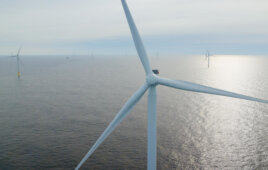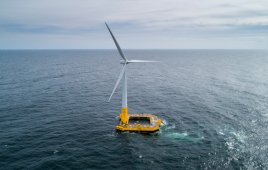
A U of Delaware study says that someday this could be the distant view from the Massachusetts’ shoreline.
A recent study by the University of Delaware’s Special Initiative on Offshore Wind (SIOW) reports that a commitment by Massachusetts to develop offshore wind (OSW) energy at a scale of 2,000 MW, combined with ongoing technology and industry advances, will lower previously projected costs for the clean energy source by as much as 55% in the next decade. That kind of cost reduction, driven by market forces, will put offshore wind on a clear path to deliver clean power at competitive prices for millions of ratepayers in the Boston area and beyond, and make the renewable resource a key contributor to the state’s clean energy future.
SIOW surveyed industry experts in the region to analyze what electricity costs would look like with 2,000 MW of offshore wind energy off Massachusetts’ coast from 2020 to 2030. The study’s key finding is that developing OSW at scale rather than on a project-by-project basis will lead to costs “far lower than previously contracted prices for offshore wind in the New England region,” with “continuing downward trajectory in cost over the decade” as OSW is built out.
The authors conclude: “An important policy finding of this study is U.S. states can, with thoughtful but straightforward policy, lower the cost of power from offshore wind.” By committing to offshore wind at scale, the report confirms that Massachusetts would be effectively enlisting the market to help it achieve that goal.
Previously proposed OSW projects in New England have had a “levelized cost of energy” (LCOE) above 24¢/kWh. The study says that costs for the first project in a 2,000 MW build-out of OSW will be much lower – 16.2¢/kWh. Further, costs will continue to decline and the last of these projects will reach a very competitive LCOE of 10.8¢/kWh.
“The key,” says lead author Dr. Willett Kempton, “is making a firm commitment to scale so the market can do its work. By providing market visibility – the State’s commitment to a pipeline of projects over a set period – the offshore wind industry in the U.S. can deliver energy costs on the kind of downward trajectory seen in Europe. More than 10 GW of offshore wind energy has been built in Europe and powers nearly 7 million homes. The U.S. has an opportunity to take advantage of this domestic clean energy resource which is in such abundant supply,” said Kempton, professor and widely-cited expert on offshore wind at the University of Delaware’s Center for Carbon-free Power Integration and College of Earth, Ocean and Environment.
Wind power has expanded rapidly on land in the U.S. – exceeding 75 GW of installed capacity and now competing on cost with all energy sources in the center of the country. But the U.S. has lagged in offshore wind power, with its first demonstration-size project beginning last summer off Rhode Island. The U.S. potential, however, remains tremendous. The study notes that in the U.S. Northeast, offshore wind is “a clean energy resource many times larger than on-land wind or rooftop solar,” and has the “potential to supply all electricity used by those coastal states.”
SIOW notes the collaborative efforts of private industry and policymakers in Europe who have recognized the benefits of this renewable resource and worked to reduce offshore wind power costs. The study benchmarks against cost-reduction trends for offshore wind costs in Europe, assessing and analyzing key cost drivers and data from offshore wind industry participants in the U.S. market. Using this methodology, the study finds that over the next decade of deployment and market learning, Massachusetts project costs can reach the industry’s targets in Europe.
“Offshore wind energy costs have dropped steadily in Europe,” said Gareth Lewis, Director, Renewables Consulting Group and former Head of Offshore Development for the UK’s 4.8 GW Dogger Bank project, the largest permitted OSW project in the world. “Massachusetts will benefit from these significant price decreases and should see prices of future projects drop even further. These are the important findings of this well-researched and well-founded report.”
“The study’s methodology looks sound and takes a credible approach that may be a good predictor of what costs will actually be in the 2020-30 period,” said Walt Musial, Manager, Offshore Wind and Ocean Power Systems, National Renewable Energy Laboratory.
“This is a thorough analysis of what offshore wind off the coast of Massachusetts is likely to cost in the near future,” said James Manwell, Professor, Department of Mechanical & Industrial Engineering, University of Massachusetts. “It is well-supported with data and tracks well with technology developments that are currently underway.”
“Working directly with industry to identify key cost drivers and projected trends, SIOW has taken a similar approach to that which we have successfully used in the UK, which has the largest offshore wind market in the world and has substantially reduced costs over time,” said Chris Hill, Program Director, Offshore Renewable Energy Catapult.
For full report: https://www.ceoe.udel.edu/about/affiliated-programs/special-initative-on-offshore-wind
The Special Initiative on Offshore Wind (SIOW) is an affiliated program at the University of Delaware’s (UD) College of Earth, Ocean & Environment (CEOE) that supports offshore wind power (OSW) as part of a comprehensive US energy solution, offering expertise, analysis, information sharing, and strategic partnership to build understanding and drive deployment. UD has a long record advancing OSW through the CEOE, College of Engineering, Center for Composite Materials and more.
Please visit us at https://www.ceoe.udel.edu/about/affiliated-programs/special-initative-on-offshore-wind and http://www.ceoe.udel.edu/research/affiliated-programs/wind-power-program.
Filed Under: News, Offshore wind




